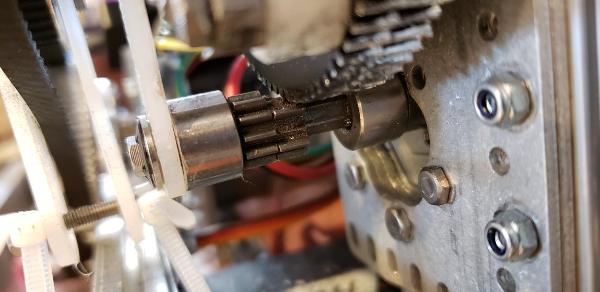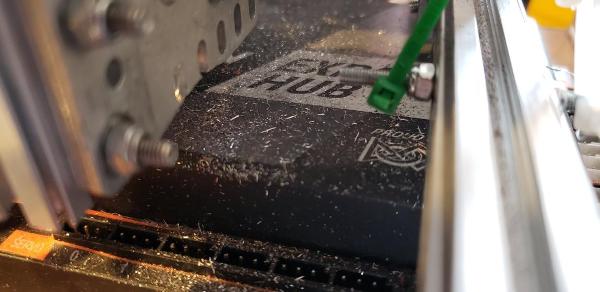Robot Issues - Gear Grinding
Tags: thinkPersonhours: 2
Task: Analyze the issues with the elbow arm of our robot

The elbow arm of the robot is what allows us to rotate the arm of our robot - the linear slides what hold the intake. Recently, while doing some drive testing, we found that the elbow wasn't acting as it should. When we took a closer look at it, we realized that the metal gears had started to destroy each other.
Before installing new gears and just having the same thing happen again, we wanted to analyze why this was happening. Remembering that pressure is equal to force divided by area, we noticed that the gears weren't fully interlocking, reducing the area for force to act on. And, the teeth of these gears are minuscule things, so the pressure on each one is immense, even more so with the full torque of the extended linear slide behind them. And, while these aluminum gears may not bend that well, under these immense pressures, they sure can break since hardness and brittleness trade off. And, even then, with high pressure and frequent use, they can still easily grind down, resulting in this scene:

But, that's not all. When we tried to run the elbow, we realized that the motor shaft themselves were out of alignment. This is hard to capture in a single picture, but this manifested itself as a sort of wobble when the motor was repeatedly run. With full, non-ground gears, this would probably be fine, but the moving shaft reduced the area of interaction between gears, contributing to the gear-dust all over our robot. Finally, as the gears were reduced to almost nothing, this wobble made it so the gears wouldn't interact at all.
The solution to this is complicated, as we only have one set of spare gears. If we had more, we would be able to replace them as needed, but currently, we couldn't guarantee that they wouldn't give out at regionals. First, we need to replace the motors, as any wobbliness reduces the area of interaction between gears, which increases the pressure on the teeth accordingly. Then, we need to create gearkeepers to hold the gears to maximum contact. We've created gearkeepers before under the same circumstances for the arm that lifts our robot up (we had a similar gear-stripping scenario), but this may not be enough alone. First, we use metal gears on the elbow, which have smaller teeth area-wise than the plastic ones elsewhere. Plus, the gearkeeper design below doesn't compensate for any later wobbliness that may occur and may wear out itself, as its essentially a nylon strap between two shafts. So, we need to design a gearkeeper that doesn't only attach from shaft to shaft but shaft-shaft-robot, as this would prevent the pesky wobbliness and decrease tooth pressure as much as possible.
Next Steps
We've forwarded this analysis to the modeling team, who will produce a print later this week so that we can bring our robot back up to snuff.
